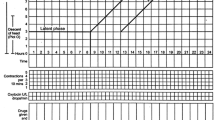Abstract
This paper presents the findings from two studies of the PartoPen system – a digital pen software application that enhances the partograph, a paper-based labor-monitoring tool used in developing regions. Previous studies have shown that correct use of the partograph significantly reduces pregnancy complications; however, partographs are not always correctly completed due to resource and training challenges. The PartoPen addresses these challenges by providing real-time decision support, instructions, and patient-specific reminders. The preliminary studies described in this paper examine how the PartoPen system affects classroom-based partograph training among nursing students at the University of Nairobi, and partograph completion in labor theater use by nurse midwives at Kenyatta National Hospital in Nairobi, Kenya. Initial results indicate that using the PartoPen system enhances student performance on partograph worksheets, and that use of the PartoPen system in labor wards positively affects partograph completion rates and nurses’ level of expertise using the partograph form.
Access this chapter
Tax calculation will be finalised at checkout
Purchases are for personal use only
Similar content being viewed by others
References
World Health Organization. Fact Sheet, World Health Organization Media Center for Maternal mortality. http://www.who.int/mediacentre/factsheets/fs348/en/index.html (2010). Retrieved 20 June 2011
Stanton, M.E.: A case for investment in maternal survival and health. Presentation at the Woodrow Wilson International Centre for Scholars, Washington, DC. http://www.wilsoncenter.org/events/docs/Mary%20Ellen%20Stanton%20Presentation.pdf (2010). Accessed 30 April 2012
Friedman, E.: The graphic analysis of labor. Am. J. Obstet. Gynecol. 68(6), 1568–1575 (1954)
Mugerwa, K.Y., Namagembe, I., Ononge, S., Omoni, G., Mwuiva, M., Wasiche, J.: The use of Partographs in Public Health Facilities in Kenya. http://www.rcqhc.org/download/FP_DOCS/Final_paper_Kenya.pdf. Accessed 30 April 2012
Lawn, J., Kerber, K.: Opportunities for Africa’s Newborns: Practical Data, Policy and Programmatic Support for Newborn Care in Africa. World Health Organization, Geneva (2006)
Levin, L.: Use of the partograph: effectiveness, training, modifications, and barriers: a literature review. Washington, DC, United States Agency for International Development, Fistula Care, EngenderHealth: 28 (2011)
Lavender, T., Omoni, G., Lee, K., Wakasiaka, S., Waitit, J., Mathai, M.: Students’ experiences of using the partograph in Kenyan labour wards. Afr. J. Midwifery Women’s Health 5(3), 117–122 (2011)
Underwood, H.: Using a digital pen to improve labor monitoring and reinforce birth attendant training. University of Colorado at Boulder, ATLAS Institute. http://www.colorado.edu/atlas/technicalreports (2011) Retrieved 1 Aug. 2011
Underwood, H., Sterling, S.R., Bennett, J.: Improving maternal labor monitoring in Kenya using digital pen technology: a user evaluation. In: Proceedings of Global Humanitarian Technology Conference, 2012 (2012)
Hartung, C., Anowka, Y., Brunette, W., Lerer, A., Tseng, C., Borriello, G.: Open data kit: tools to build information services for developing regions. In: Proceedings of the ACM/IEEE Conference on Information and Communication Technology for Development, London, United Kingdom, 13–16 December 2010 (2010)
Grameen Foundation. Mobile Technology for Community Health. http://www.grameenfoundation.org/what-we-do/technology/mobile-health (2010). Retrieved 2 July 2011
Parikh, T.: CAM: a mobile interaction framework for digitizing paper processes in the developing world. In: Proceedings of ACM Symposium on User Interface Software and Technology (UIST), Seattle, Washington, 23–26 October 2005 (2005)
Sherwani, J., et al.: HealthLine: speech-based access to health information by low-literate users (2007)
Svoronos, T., et al.: CommCare: automated quality improvement to strengthen community-based health the need for quality improvement for CHWs. Health (San Francisco) (2010)
Derenzi, B., Mitchell, M., Schellenberg, D., Lesh, N., Sims, C., Maokola, W.: e-IMCI: improving pediatric health care in low-income countries (2008)
Dell, N., Breit, N., Crawford, J.: Digitizing paper forms with mobile imaging technologies. In: Second Annual Symposium on Computing for Development (2012)
Ratan, A.L., Chakraborty, S., Chitnis, P.V., Toyama, K., Ooi, K.S., Phiong, M., Koenig, M.: Managing microfinance with paper, pen and digital slate. Scientia 196(36) (2010)
Yeh, R., Liao, C., et al.: ButterflyNet: a mobile capture and access system for field biology research. In: Proceedings of the SIGCHI Conference on Human Factors in Computing Systems, Montreal, Quebec, Canada, 22–27 April 2006 (2006)
Cowan, L.P., Griswold, W., Weibel, N., Hollan, J.: UbiSketch: bringing sketching out of the closet. La Jolla, University of California, San Diego: 10 (2011)
Song, H., Benko, H., et al.: Grips and gestures on a multi-touch pen. In: Proceedings of the 2011 Annual Conference on Human Factors in Computing Systems, Vancouver, BC, Canada, 7–12 May 2011 (2011)
Landau, S., Bourquin, G., van Schaack, A., Miele, J.: Demonstration of a universally accessible audio-haptic transit map built on a digital pen-based platform. In: 3rd International Haptic and Auditory interaction Design Workshop, Jyvaskyla, Finland, 15–16 September 2008 (2008)
Sarcevic, A.: TraumaPen: supporting documentation and situational awareness through real-time data capture and presentation in safety-critical work. Technical report, Computer Science Department, University of Colorado at Boulder (2010)
Jhpiego Corporation. E-Partogram. Saving Lives at Birth: A Grand Challenge for Development. http://www.savinglivesatbirth.net/summaries/35 (2011)
Mathai, M.: WHO Partograph E-learning Course. World Health Organization. http://streaming.jointokyo.org/viewerportal/vmc/player.do?eventContentId=995 (2010)
Acknowledgements
This research is funded by a Gates Grand Challenge in Global Health grant, a National Science Foundation Graduate Research Fellowship, and by the ATLAS Institute at the University of Colorado Boulder. We would like to thank the leadership of KNH, PMH, and the UoN, particularly Dr. John Ong’ech and Dr. Grace Omoni, for their support and cooperation during the PartoPen studies, and all of the students, nurses, and staff who participated in the studies. Research assistants Maya Appley, Addie Crawley, Sara Rosenblum, and Vincent Ochieng contributed significantly to this study.
Author information
Authors and Affiliations
Corresponding author
Editor information
Editors and Affiliations
Appendix: KNH Partograph Form
Appendix: KNH Partograph Form

Rights and permissions
Copyright information
© 2014 Springer-Verlag Berlin Heidelberg
About this paper
Cite this paper
Underwood, H., Ong’ech, J., Omoni, G., Wakasiaka, S., Sterling, S.R., Bennett, J.K. (2014). Improving Partograph Training and Use in Kenya Using the Partopen Digital Pen System. In: Fernández-Chimeno, M., et al. Biomedical Engineering Systems and Technologies. BIOSTEC 2013. Communications in Computer and Information Science, vol 452. Springer, Berlin, Heidelberg. https://doi.org/10.1007/978-3-662-44485-6_28
Download citation
DOI: https://doi.org/10.1007/978-3-662-44485-6_28
Published:
Publisher Name: Springer, Berlin, Heidelberg
Print ISBN: 978-3-662-44484-9
Online ISBN: 978-3-662-44485-6
eBook Packages: Computer ScienceComputer Science (R0)




